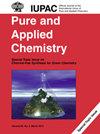作为 "可持续发展全球对话 "一部分的一篇报道:使用新型生物方解石材料进行染料吸附研究
IF 2
4区 化学
Q3 CHEMISTRY, MULTIDISCIPLINARY
引用次数: 0
摘要
联合国的许多可持续发展目标(SDGs)都可以通过化学来实现。在过去的两年里,加拿大纽芬兰纪念大学的研究人员一直通过 "可持续发展全球对话 "在 9 月 25 日分享他们的故事。本文介绍了其中一个故事的细节。随着全球人口的增加,包括水产养殖在内的粮食生产也在不断增长。与此同时,这也意味着会产生更多的废物。水产养殖产生的废物作为宝贵的化学品来源往往被忽视。养殖蓝贻贝(Mytilus edulis)产生的副产品主要是富含方解石的贝壳。研究人员通过加热和醋酸处理相结合的方法,从废弃贻贝中制备出一种 "软 "方解石材料,研究其吸附特性及其在废水修复中的应用可能性。通过建立等温模型和动力学模型,评估了亚甲基蓝和黄芩苷-O 这两种阳离子染料在这种材料上的吸附情况。亚甲基蓝和沙弗宁-O 的吸附系统可以用 Langmuir 等温线进行最佳描述,吸附容量分别为 1.81 和 1.51 毫克/克。吸附过程以假二阶速率动力学为主。与迄今为止报告的其他软体动物衍生材料进行了比较。本文章由计算机程序翻译,如有差异,请以英文原文为准。
One story as part of the Global Conversation on Sustainability: dye adsorption studies using a novel bio-derived calcite material
Many of the United Nations’ Sustainable Development Goals (SDGs) can be addressed through chemistry. Researchers at Memorial University of Newfoundland, Canada, have been sharing their stories on September 25 for the past two years through the Global Conversation on Sustainability. This article describes the details of one of these stories. As the global population increases, food production including aquaculture is increasing to provide for this. At the same time, this means more waste is produced. Waste from aquaculture is often overlooked as a source of valuable chemicals. By-products from farming blue mussels (Mytilus edulis ) is dominated by shells rich in calcite. A ‘soft’ calcite material prepared from waste mussels, via a combination of heat and acetic acid treatment, was investigated for its adsorptive properties and its possible use in wastewater remediation. The adsorption of two cationic dyes, methylene blue and safranin-O, on this material were evaluated through isothermal and kinetic modelling. The adsorption systems for both methylene blue and safranin-O can best be described using Langmuir isotherms and the respective adsorption capacities were 1.81 and 1.51 mg/g. The adsorption process was dominated by pseudo-second order rate kinetics. Comparisons are made with other mollusc-derived materials reported to date.
求助全文
通过发布文献求助,成功后即可免费获取论文全文。
去求助
来源期刊

Pure and Applied Chemistry
化学-化学综合
CiteScore
4.00
自引率
0.00%
发文量
60
审稿时长
3-8 weeks
期刊介绍:
Pure and Applied Chemistry is the official monthly Journal of IUPAC, with responsibility for publishing works arising from those international scientific events and projects that are sponsored and undertaken by the Union. The policy is to publish highly topical and credible works at the forefront of all aspects of pure and applied chemistry, and the attendant goal is to promote widespread acceptance of the Journal as an authoritative and indispensable holding in academic and institutional libraries.
 求助内容:
求助内容: 应助结果提醒方式:
应助结果提醒方式:


